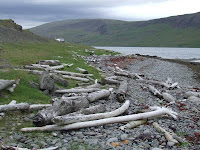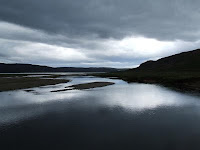
Currently, highlights of this travel come to me faster than I can digest them... there were enough exciting things yesterday that could have easily filled three or four days. So today I have to take it all more slowly.
I left Reykjavik to go north again, in order to see some further places that I missed on my first round. I drove until I reached Reykholt and checked in at a bed&breakfast farm named Nes, thinking I would do nothing more that day other than write my blog. But things came differently.

The 76-year-old farmer who manages this place, Bjarni, turned out to be a most enterprising man. He was a former dairy farmer, but since a few years he gave up the cows and now makes hay, runs the guesthouse and has built a golf course on his land. He heard of my travel in the footsteps of you-know-whom, and that I would like to see Surtshellir, the lava cave that Konrad had explored on the 5th of September 1858.

Konrad called
Surtshellir "eine der Hauptmerkwuerdigkeiten der Insel". It is a lava tube and was created about 1000 years ago when a mighty stream of liquid and very hot lava rushed through here and formed its own tunnel. The cave is 7.5 km from the main road and so I could not go there with my small car, which is why Bjarni offered to take me there in his 4WD car and show me the cave -- right away on the same evening. We started at 9 pm and came back from the expedition just after midnight.

The first curiosity on the way to the cave was "Hraunkarl", a face in a lava boulder (see the top photo). I expected to hear a story about it, such as of it being the head of a petrified troll, but there seems to be no old story about it -- whereas there are lots of other stories that Bjarni told me on the way, stories on just about every hill, valley, or lava field we passed by, and where their names come from -- much more than I could remember or repeat.
We had equipped ourselves for the cave with good walking shoes, jackets and torches. (Konrad and his company had used
Pechfackeln in 1858). The best entrance to the cave is to enter it from the north, where the roof of the tunnel has collapsed creating a funnel-like opening, filled with big angular boulders that aid you in climbing down.

The floor inside the cave is for the most part not really anything that could be called a floor, it is completely filled with these same big angular rocks that have fallen from its ceiling. I would not want to be in this cave during an earthquake! Every winter, water seeps in the cracks between the rocks and freezes, loosening more of the material.
So to make your way through the tunnel, you must climb very carefully from one rock to the next, and the rocks often jiggle under your foot. I was initially worried about the old man, but he climbed ahead of me with a very sure step.
There are practically no stalactites to be seen here, but on the walls and parts of the floor you can see structures made by the hot lava. I learned that there is a saga about this place, or actually several sagas, about outlaws who lived here, robbers of sheep.

After a short distance the tunnel comes to daylight again, as a longer section of the roof has collapsed here. It is said that this section was used by the outlaws to kill the stolen sheep by driving them over the edge of the wall, where they would fall to their death.
After this opening, the tunnel continues, becomes bigger and wider, and here the cave has several connected side tubes, that show traces of humans living here. Bjarni led me to a place where you could still see old bones from sheep covering the floor (he told me this used to be a much bigger pile some decades ago, but people have, although it is forbidden, taken them away piece by piece as souvenirs). Next to the bone-place is a structure easily recognizable as an old fireplace.
We made our way back the same way that we came, and that was not all for the day, as another highlight offered itself on the way back, which will be subject of my next posting. Sorry for all you poor guys who have to read this!
 Sorry for the silly title, I'm a little hyped up. It's my last day in Iceland today (Sunday) and I'm so full with all the excitement of the past weeks.
Sorry for the silly title, I'm a little hyped up. It's my last day in Iceland today (Sunday) and I'm so full with all the excitement of the past weeks.

















































